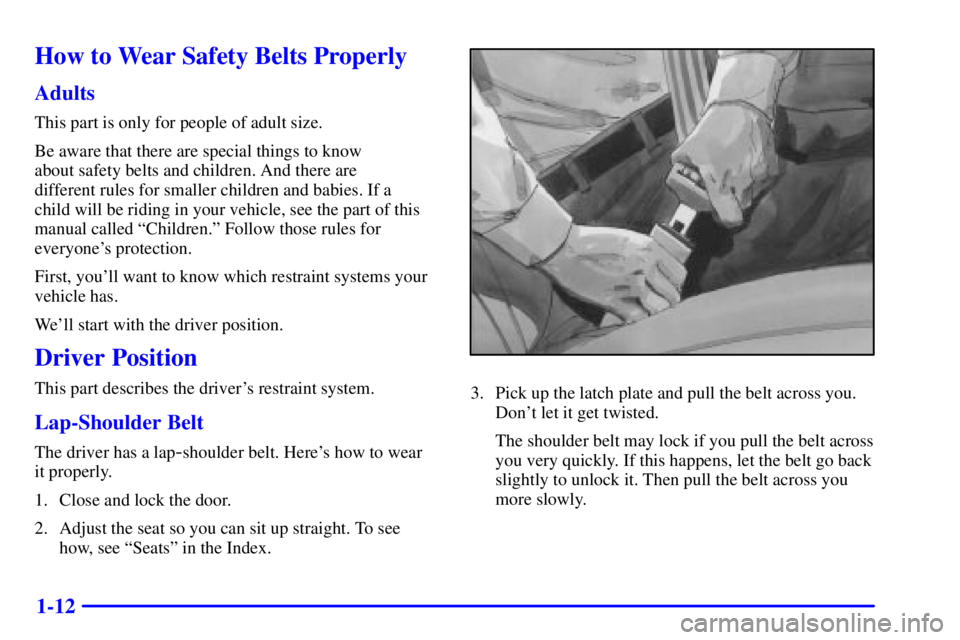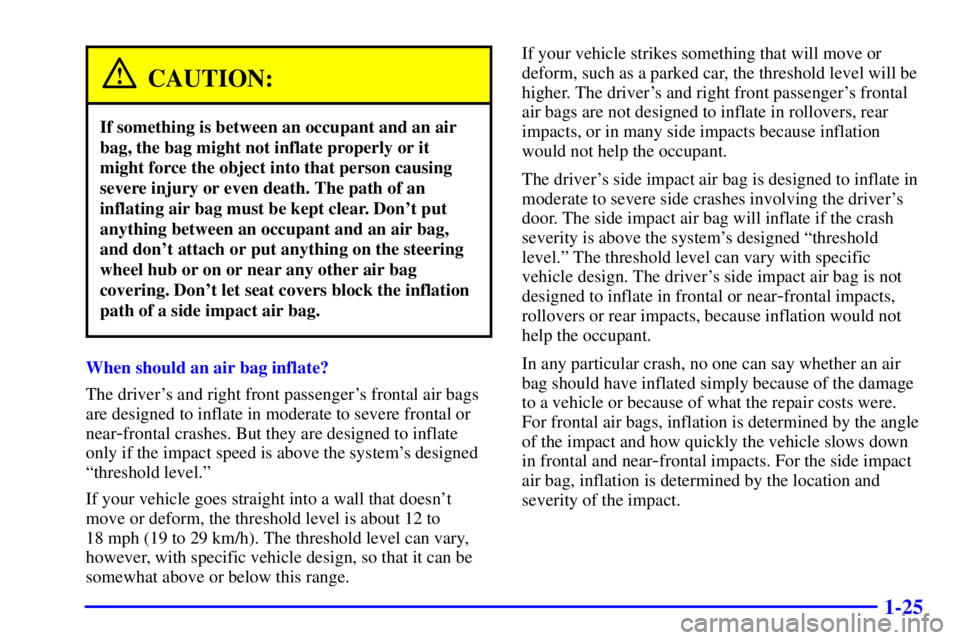Page 18 of 368

1-12
How to Wear Safety Belts Properly
Adults
This part is only for people of adult size.
Be aware that there are special things to know
about safety belts and children. And there are
different rules for smaller children and babies. If a
child will be riding in your vehicle, see the part of this
manual called ªChildren.º Follow those rules for
everyone's protection.
First, you'll want to know which restraint systems your
vehicle has.
We'll start with the driver position.
Driver Position
This part describes the driver's restraint system.
Lap-Shoulder Belt
The driver has a lap-shoulder belt. Here's how to wear
it properly.
1. Close and lock the door.
2. Adjust the seat so you can sit up straight. To see
how, see ªSeatsº in the Index.
3. Pick up the latch plate and pull the belt across you.
Don't let it get twisted.
The shoulder belt may lock if you pull the belt across
you very quickly. If this happens, let the belt go back
slightly to unlock it. Then pull the belt across you
more slowly.
Page 26 of 368

1-20
The best way to protect the fetus is to protect the
mother. When a safety belt is worn properly, it's more
likely that the fetus won't be hurt in a crash. For
pregnant women, as for anyone, the key to making
safety belts effective is wearing them properly.
Right Front Passenger Position
To learn how to wear the right front passenger's
safety belt properly, see ªDriver Positionº earlier in
this section.
The right front passenger's safety belt works the same
way as the driver's safety belt
-- except for one thing.
If you ever pull the shoulder portion of the belt out all
the way, you will engage the child restraint locking
feature. If this happens, just let the belt go back all
the way and start again.
Air Bag Systems
This part explains the frontal and side impact air
bag systems.
Your vehicle has air bags
-- a frontal air bag for the
driver and another frontal air bag for the right front
passenger. Your vehicle may also have a side impact air
bag for the driver. If your vehicle has a side impact air
bag for the driver it will say AIR BAG on the air bag
covering on the side of the driver's seatback closest to
the door.
Page 31 of 368

1-25
CAUTION:
If something is between an occupant and an air
bag, the bag might not inflate properly or it
might force the object into that person causing
severe injury or even death. The path of an
inflating air bag must be kept clear. Don't put
anything between an occupant and an air bag,
and don't attach or put anything on the steering
wheel hub or on or near any other air bag
covering. Don't let seat covers block the inflation
path of a side impact air bag.
When should an air bag inflate?
The driver's and right front passenger's frontal air bags
are designed to inflate in moderate to severe frontal or
near
-frontal crashes. But they are designed to inflate
only if the impact speed is above the system's designed
ªthreshold level.º
If your vehicle goes straight into a wall that doesn't
move or deform, the threshold level is about 12 to
18 mph (19 to 29 km/h). The threshold level can vary,
however, with specific vehicle design, so that it can be
somewhat above or below this range.If your vehicle strikes something that will move or
deform, such as a parked car, the threshold level will be
higher. The driver's and right front passenger's frontal
air bags are not designed to inflate in rollovers, rear
impacts, or in many side impacts because inflation
would not help the occupant.
The driver's side impact air bag is designed to inflate in
moderate to severe side crashes involving the driver's
door. The side impact air bag will inflate if the crash
severity is above the system's designed ªthreshold
level.º The threshold level can vary with specific
vehicle design. The driver's side impact air bag is not
designed to inflate in frontal or near
-frontal impacts,
rollovers or rear impacts, because inflation would not
help the occupant.
In any particular crash, no one can say whether an air
bag should have inflated simply because of the damage
to a vehicle or because of what the repair costs were.
For frontal air bags, inflation is determined by the angle
of the impact and how quickly the vehicle slows down
in frontal and near
-frontal impacts. For the side impact
air bag, inflation is determined by the location and
severity of the impact.
Page 65 of 368

2-
2-1
Section 2 Features and Controls
Here you can learn about the many standard and optional features on your vehicle, and information on starting,
shifting and braking. Also explained are the instrument panel and the warning systems that tell you if everything is
working properly
-- and what to do if you have a problem.
2
-2 Windows
2
-4 Keys
2
-6 Door Locks
2
-10 Remote Keyless Entry
2
-17 Trunk
2
-22 Theft
2
-23 PASS-Key� II
2
-24 New Vehicle ªBreak-Inº
2
-25 Ignition Positions
2
-26 Starting Your Engine
2
-27 Engine Coolant Heater (If Equipped)
2
-28 Automatic Transaxle Operation
2
-33 Parking Brake
2
-34 Shifting Into PARK (P)
2
-36 Shifting Out of PARK (P)
2
-37 Parking Over Things That Burn
2
-38 Engine Exhaust
2
-38 Running Your Engine While You're Parked2
-39 Horn
2
-39 Tilt Wheel
2
-40 Turn Signal/Multifunction Lever
2
-46 Exterior Lamps
2
-49 Interior Lamps
2
-52 Mirrors
2
-56 Storage Compartments
2
-58 Sun Visors
2
-58 Auxiliary Power Outlet
2
-59 Auxiliary Power Connection (Power Drop)
2
-60 OnStar�System (If Equipped)
2
-64 Sunroof (Option)
2
-65 The Instrument Panel -- Your
Information System
2
-66 Instrument Panel Cluster
2
-68 Warning Lights, Gages and Indicators
2
-82 Driver Information Center (Option)
Page 67 of 368
2-3 Power Windows
The switches on the driver's door armrest can be used
to control each of the windows when the ignition is on.
In addition, each passenger's door has a window.Express
-Down Window
The driver's window switch has an express
-down
feature. This switch is labeled AUTO. Tap the rear of
the switch and the driver's window will open a small
amount. If the rear of the switch is pressed all the
way down, the window will go all the way down.
To stop the window while it is lowering, press the front
of the switch. To raise the window, press and hold the
front of the switch.
The driver's window controls also include a lock
-out
switch. Press LOCK to stop front and rear passengers
from using their window switches. The driver can still
control all the windows with the lock on. Press the other
side of the LOCK switch for normal window operation.
Page 69 of 368
2-5
The ignition key is for the
ignition only.
The door key is for the
doors and all other locks.The ignition and door keys don't have plugs. Your
dealer or Buick Roadside Assistance has the code for
your keys.
If you need a new ignition or door key, contact
your dealer who can obtain the correct key code.
Also, see ªRoadside Assistanceº in the Index for
more information.
NOTICE:
Your vehicle has a number of features that can
help prevent theft. But you can have a lot of
trouble getting into your vehicle if you ever
lock your keys inside. You may even have to
damage your vehicle to get in. So be sure you
have extra keys.
If your vehicle is equipped with the OnStar� system
with an active subscription and you lock your keys
inside the vehicle, OnStar may be able to send a
command to unlock your vehicle. See ªOnStarº in
the Index for more information.
Page 70 of 368
2-6
Door Locks
CAUTION:
Unlocked doors can be dangerous.
�Passengers -- especially children -- can
easily open the doors and fall out of a
moving vehicle. When a door is locked,
the handle won't open it. You increase the
chance of being thrown out of the vehicle
in a crash if the doors aren't locked.
So, wear safety belts properly and lock
the doors whenever you drive.
�Young children who get into unlocked
vehicles may be unable to get out. A child
can be overcome by extreme heat and can
suffer permanent injuries or even death
from heat stroke. Always lock your vehicle
whenever you leave it.
�Outsiders can easily enter through an
unlocked door when you slow down or stop
your vehicle. Locking your doors can help
prevent this from happening.
There are several ways to lock and unlock your vehicle.
From the outside, use your door key or remote keyless
entry transmitter.
From the inside, to manually lock the door, push the
lever forward. To unlock, push the lever rearward.
Page 71 of 368

2-7 Power Door Locks
Your vehicle is equipped
with front power door lock
switches. Press a power
door lock switch to lock
or unlock all doors.
The rear doors do not have power door lock switches.
Use the manual lock levers to lock or unlock each
rear door.
Programmable Automatic Power
Door Locks
Programmable automatic power door locks are intended
to provide enhanced security and convenience by
automatically locking and unlocking doors. This
feature provides four operating modes.Programmable Modes
Your vehicle can be programmed to one of the
following modes.
Mode 1: No automatic door lock or unlock.
Mode 2:
�Automatic all
-door lock when the transaxle is shifted
out of PARK (P); no automatic door unlock.
�Automatic door relock when any door is unlocked,
opened and then all doors are again closed while the
vehicle is not in PARK (P) or NEUTRAL (N) and
the driver's foot is on the brake pedal.
Mode 3:
�Automatic all
-door lock when the transaxle is shifted
out of PARK (P).
�Automatic all
-door unlock when the transaxle is
shifted into PARK (P).
�Automatic door relock when any door is unlocked,
opened and then all doors are closed again while the
vehicle is not in PARK (P) or NEUTRAL (N) and
the driver's foot is on the brake pedal.